Discharge Characteristics and Mechanisms of Electrolytic Discharge Processing by Jet Mask
Abstract
:1. Introduction
2. Discharge Experimental Research on Jet-ECDM
2.1. Discharge Phenomena during Jet-EDCM
2.2. Characterisation of Crater Morphology under Discharge Conditions
3. Electric Field Simulation Analysis Study of Jet-ECDM
3.1. Modelling Multi-Physics Field Coupling
3.2. Simulation Analysis of Electric Field Distribution
4. Discharge Mechanism Analysis of Jet-ECDM
5. Conclusions
- (1)
- An experimental study of high-voltage jet electrolytic discharge was carried out, with a high-speed camera recording the jet flow column. The results show that the discharge channel is preceded by a pilot discharge in the middle of the bottom mask hole, with the discharge channel developing bottom-up along the middle of the gas–liquid flow column and achieving penetration between the two poles to achieve a large-gap long-distance discharge. The discharge of the jet stream column is strongest when the tool electrode is moving directly above the workpiece material, which is completely unobstructed by the mask, creating a bright spark channel. The study also shows that Jet-ECDM does not have a bubble-forming gas film process; the discharge is not caused by gas film breakdown and does not have the typical preconditions for ECDM discharge.
- (2)
- Optical microscope observation studies of the workpiece morphology showed that when the machining voltage was 400V, a steady continuous spark appeared and the discharge marks produced at the bottom of the crater had the distinctive feature of a flat circle-like structure with a random specific shape and no serious damage to the mask, which had a good constraint on the machined morphology, inhibiting its width growth, promoting its longitudinal machining, and enhancing the removal of material. The experimental results further show that the high-pressure jet electrolyte helps to remove residual debris within the machined area, and the 3D images of the machined craters show that debris has been effectively removed, even under high pressure and long-distance discharge conditions, improving machining efficiency.
- (3)
- The electric field simulation model of the flow column channel was constructed based on COMSOL software, and the results showed that the field strength and potential at the gas–liquid boundary were both 0, while the potential inside the jet flow column decreased from the initial value to 0 from the bottom up. The study further showed that the electric field action range is limited by the mask to the mechanical area, and the marginal effect of the electric field makes the electric field strength of the exposed workpiece gradually increase from the edge to the centre, and the maximum of the electric field exists in the centre of the mask hole.
- (4)
- The mechanism of the discharge phenomenon is analysed and studied; firstly, an electrolytic reaction occurs to generate gas, which escapes in the form of bubbles. A mathematical derivation shows the dielectric electric field is composed of electrolyte and bubble; the actual field strength inside the bubble of this model is stronger than the critical field strength of air bubble breakdown in the standard state, and the bubble breakdown occurs in the discharge. The small bubbles break down one by one and are gradually arranged in the direction of the electric field to form small bridges, which run through both poles (i.e., the tool and the workpiece) and finally lead to the breakdown of the entire gas–liquid two-phase mixing channel.
Author Contributions
Funding
Institutional Review Board Statement
Informed Consent Statement
Data Availability Statement
Conflicts of Interest
References
- Chu, W.S.; Kim, C.S.; Lee, H.T.; Choi, J.-O.; Park, J.-I.; Song, J.-H.; Jang, K.-H. Hybrid manufacturing in micro/nano scale: A review. Int. J. Precis. Eng. Manuf.-Green Technol. 2014, 1, 75–92. [Google Scholar] [CrossRef]
- Singh, T.; Dvivedi, A. Developments in electrochemical discharge machining: A review on electrochemical discharge machining, process variants and their hybrid methods. Int. J. Mach. Tools Manuf. 2016, 105, 1–13. [Google Scholar] [CrossRef]
- Singh, T.; Appalanaidu, B.; Dvivedi, A. Improvement in energy channelization behaviour during micro hole formation in Y-SZ ceramic with magnetic field assisted ECSM process. Measurement 2022, 194, 111079. [Google Scholar] [CrossRef]
- Wüthrich, R.; Ziki, J.D.A. Index—Micromachining Using Electrochemical Discharge Phenomenon, 2nd ed.; Elsevier: Amsterdam, The Netherlands, 2015; pp. 203–208. ISBN 9780323241427. [Google Scholar]
- Singh, T.; Dvivedi, A. On prolongation of discharge regime during ECDM by titrated flow of electrolyte. Int. J. Adv. Manuf. Technol. 2020, 107, 1819–1834. [Google Scholar] [CrossRef]
- Zhang, Y.; Xu, Z.; Xing, J.; Zhu, D. Effect of tube-electrode inner diameter on electrochemical discharge machining of nickel-based superalloy. Chin. J. Aeronaut. 2016, 29, 1103–1110. [Google Scholar] [CrossRef]
- Singh, T.; Dvivedi, A. On energy channelization analysis for ECSM process during fabrication of microchannels in glass. Mater. Manuf. Process. 2021, 37, 1–5. [Google Scholar] [CrossRef]
- Singh, Y.P.; Jain, V.K.; Kumar, P.; Agrawal, D.C. Machining piezoelectric (PZT) ceramics using an electrochemical spark machining (ECSM) process. J. Mater. Process. Technol. 1996, 58, 24–31. [Google Scholar] [CrossRef]
- Singh, T.; Dvivedi, A. Fabrication of micro holes in Yttria-stabilized zirconia (Y-SZ) by hybrid process of electrochemical discharge machining (ECDM). Ceram. Int. 2021, 47, 23677–23681. [Google Scholar] [CrossRef]
- Gupta, P.K.; Dvivedi, A.; Kumar, P. Developments on electrochemical discharge machining: A review of experimental investigations on tool electrode process parameters. Proc. Inst. Mech. Eng. Part B J. Eng. Manuf. 2015, 229, 910–920. [Google Scholar] [CrossRef]
- Singh, T.; Dvivedi, A. On performance evaluation of textured tools during micro-channeling with ECDM. J. Manuf. Process. 2018, 32, 699–713. [Google Scholar] [CrossRef]
- Behzadiana, M.; Otaghsara, S.K.; Yazdani, M.; Ignatius, J. Astate-of-the-art survey of TOPSIS applications. Expert Syst. Appl. 2012, 39, 13051–13069. [Google Scholar] [CrossRef]
- Nayak, B.B.; Mahapatra, S.S. Multi-response optimization of WEDM Process Parameters using the AHP and TOPSIS method. Int. J. Theor. Appl. Res. Mech. Eng. 2013, 2, 109–215. [Google Scholar]
- Nguyen, P.; Banh, L.; Bui, V.; Hoang, D. Multi-response optimization of process parameters for powder mixed electro-discharge machining according to the surface roughness and surface micro-hardness using Taguchi-TOPSIS. Int. J. Data Netw. Sci. 2018, 2, 109–119. [Google Scholar] [CrossRef]
- Parthiban, K.; Duraiselvam, M.; Manivannan, R. TOPSIS based parametric optimization of laser micro-drilling of TBC coated nickel based superalloy. Opt. Laser Technol. 2018, 102, 32–39. [Google Scholar] [CrossRef]
- Ladeesh, V.G.; Manu, R. Machining of fluidic channels on borosilicate glass using grinding-aided electrochemical discharge engraving (G-ECDE) and process optimization. J. Braz. Soc. Mech. Sci. 2018, 40, 1–19. [Google Scholar] [CrossRef]
- Ananthakumar, K.; Rajamani, D.; Balasubramanian, E.; Davim, J.P. Measurement and optimization of multi-response characteristics in plasma arc cutting of Monel 400™ using RSM and TOPSIS. Measurement 2018, 135, 725–737. [Google Scholar] [CrossRef]
- Ishfaq, K.; Maqsood, M.A.; Anwar, S.; Alfaify, A.; Zia, A.W. Analyzing micromachining errors in EDM of Inconel 600 using various biodegradable. J. Braz. Soc. Mech. Sci. Eng. 2022, 44, 249. [Google Scholar] [CrossRef]
- Ishfaq, K.; Maqsood, M.A.; Anwar, S.; Harris, M.; Alfaify, A.; Zia, A.W. EDM of Ti6Al4V under nano-graphene mixed dielectric: A detailed roughness analysis. Int. J. Adv. Manuf. 2022, 120, 7375–7388. [Google Scholar] [CrossRef]
- Ishfaq, K.; Waseem, M.U.; Sana, M. Investigating cryogenically treated electrodes’ performance under modified dielectric(s) for EDM of Inconel (617). Mater. Manuf. Process. 2022, 37, 1902–1911. [Google Scholar] [CrossRef]
- Madhavi, J.B.; Hiremath, S.S. Machining and Characterization of Channels and Textures on Quartz Glass Using μ-ECDM Process. Silicon 2019, 11, 2919–2931. [Google Scholar] [CrossRef]
- Ladeesh, V.G.; Manu, R. Grinding-aided electrochemical discharge drilling in the light of electrochemistry. Proc. Inst. Mech. Eng. Part C J. Mech. Eng. Sci. 2019, 233, 1896–1909. [Google Scholar] [CrossRef]
- Bhargav, K.V.J.; Shanthan, P.; Balaji, P.S.; Sahu, R.K.; Sahoo, S.K. Generation of microholes on GFRP composite using ES-µ-ECDM system. CIRP J. Manuf. Sci. Technol. 2022, 38, 695–705. [Google Scholar] [CrossRef]
- Tripathy, S.; Tripathy, D.K. Multi-attribute optimization of machining process parameters in powder mixed electro-discharge machining using TOPSIS and grey relational analysis. Eng. Sci. Technol. Int. J. 2016, 19, 62–70. [Google Scholar] [CrossRef]
- Han, Y.; Liu, Z.; Cao, Z.; Kong, L.; Qiu, M. Mechanism study of the combined process of electrical discharge machining ablation and electrochemical machining in aerosol dielectric. J. Mater. Process. Technol. 2018, 254, 221–228. [Google Scholar] [CrossRef]
- Julfekar, A.; Karan, P.; Pradeep, D. Effect of tool-electrode material in through-hole formation using ECDM process. Mater. Manuf. Process. 2021, 36, 1019–1027. [Google Scholar]
- Zhang, X.; Song, X.; Ming, P.; Li, X.; Zeng, Y.; Cai, J. The Effect of Electrolytic Jet Orientation on Machining Characteristics in Jet Electrochemical Machining. Micromachines 2019, 10, 404. [Google Scholar] [CrossRef]
- Fan, G.; Chen, X.; Saxena, K.K.; Liu, J.; Guo, Z. Jet Electrochemical Micromachining of Micro-Grooves with Conductive-Masked Porous Cathode. Micromachines 2020, 11, 557. [Google Scholar] [CrossRef] [PubMed]
- He, J.; Wang, Z.; Zhou, W.; Jian, Y.; Zhou, L. Electrolytic Characteristics of Microhole Array Manufacturing Using Polyacrylamide Electrolyte in 304 Stainless Steel. Micromachines 2023, 14, 1808. [Google Scholar] [CrossRef]
- Chen, X.; Dong, B.; Zhang, C.; Luo, H.P.; Liu, J.W.; Zhang, Y.J.; Guo, Z.N. Electrochemical direct-writing machining of microchannel array. J. Mater. Process. Technol. 2019, 265, 138–149. [Google Scholar] [CrossRef]
- Zhan, S.; Lyu, Z.; Dong, B.; Liu, W.; Zhao, Y. Cathodic discharge plasma in electrochemical jet machining: Phenomena, mechanism and characteristics. Int. J. Mach. Tools Manuf. 2023, 187, 104015–104032. [Google Scholar] [CrossRef]
- Mayank, G.; Fuchen, C.; Masanori, K. Analysis of Reactions Determining Current Efficiency in Electrochemical Machining. Procedia CIRP 2018, 68, 511–516. [Google Scholar] [CrossRef]
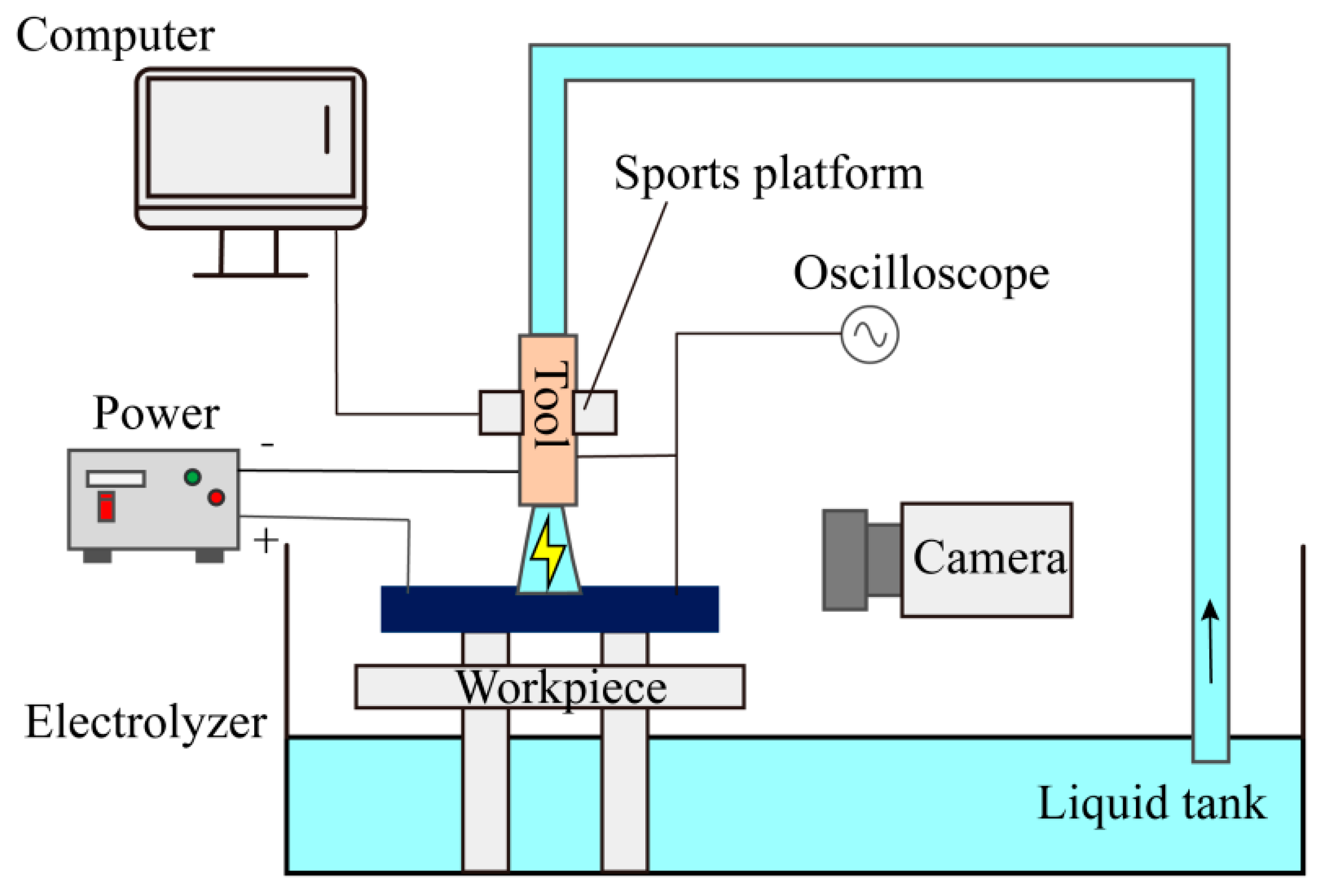
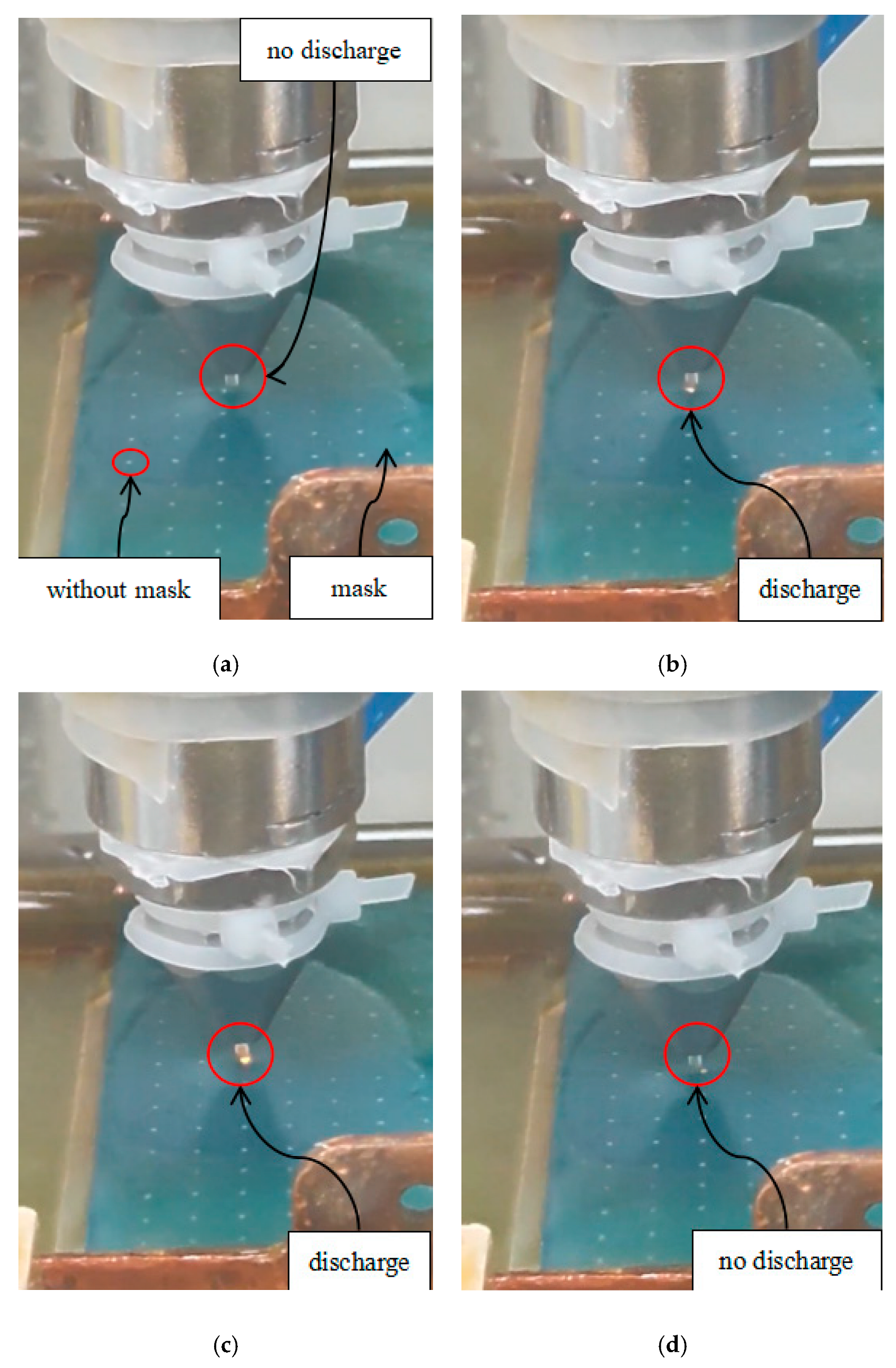

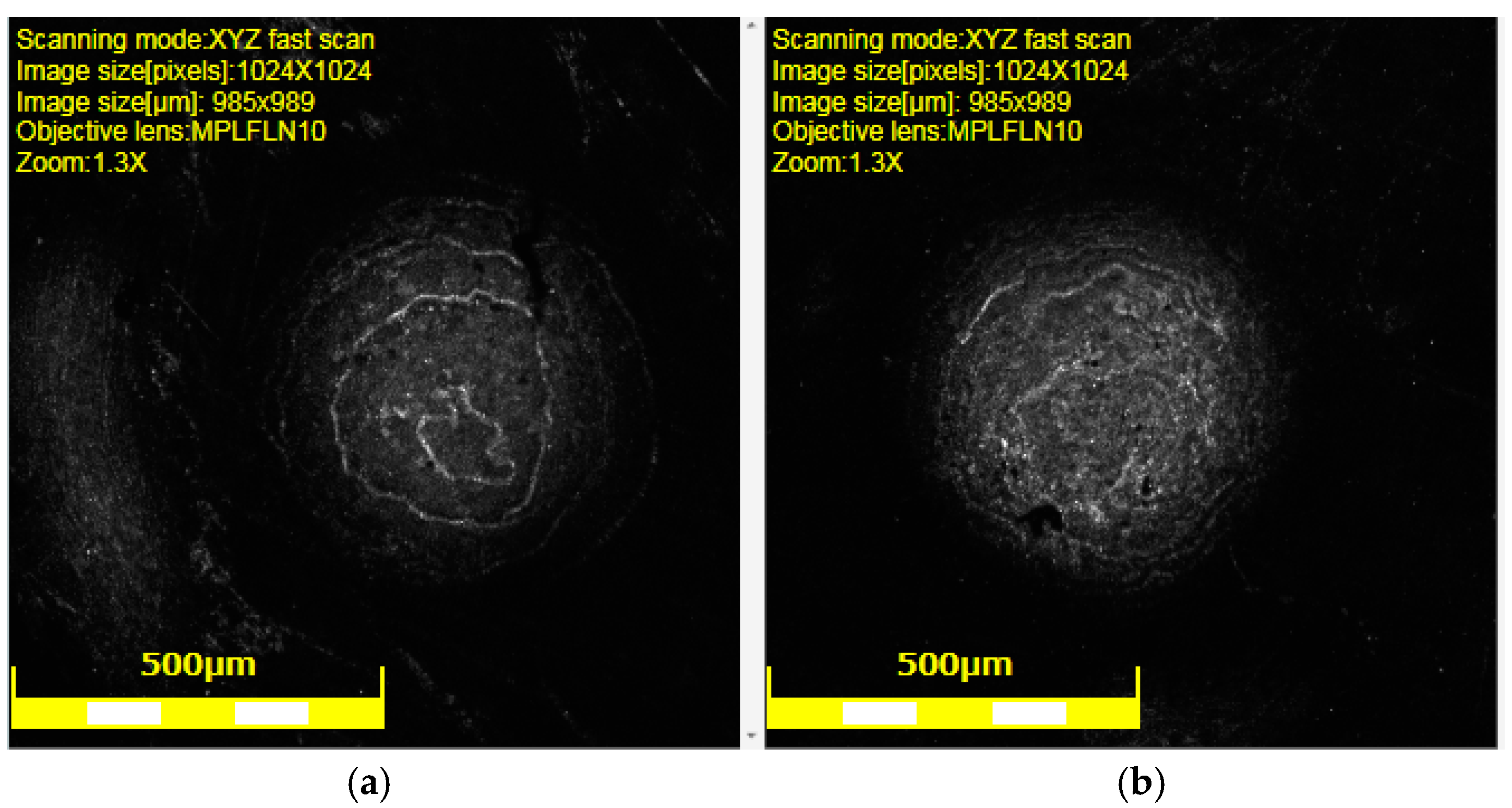
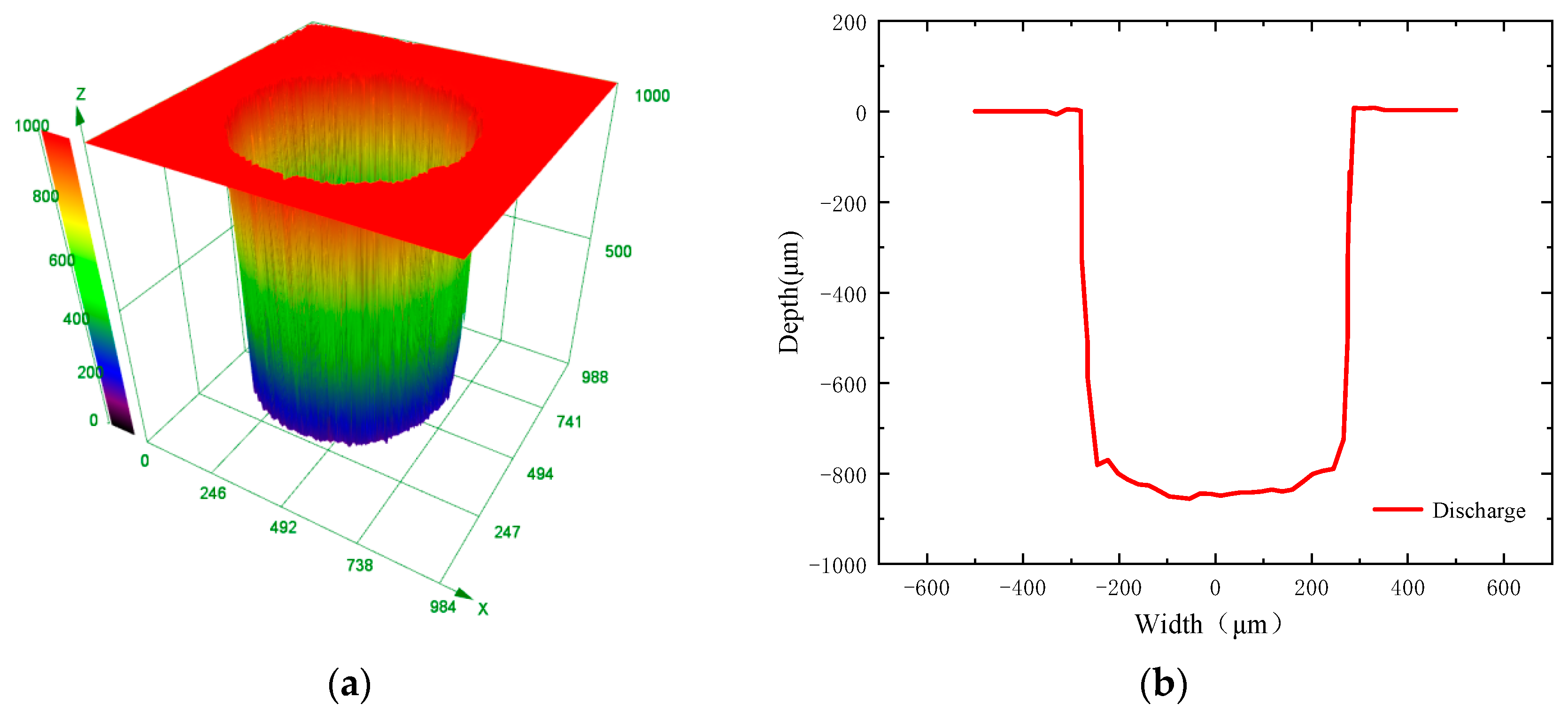
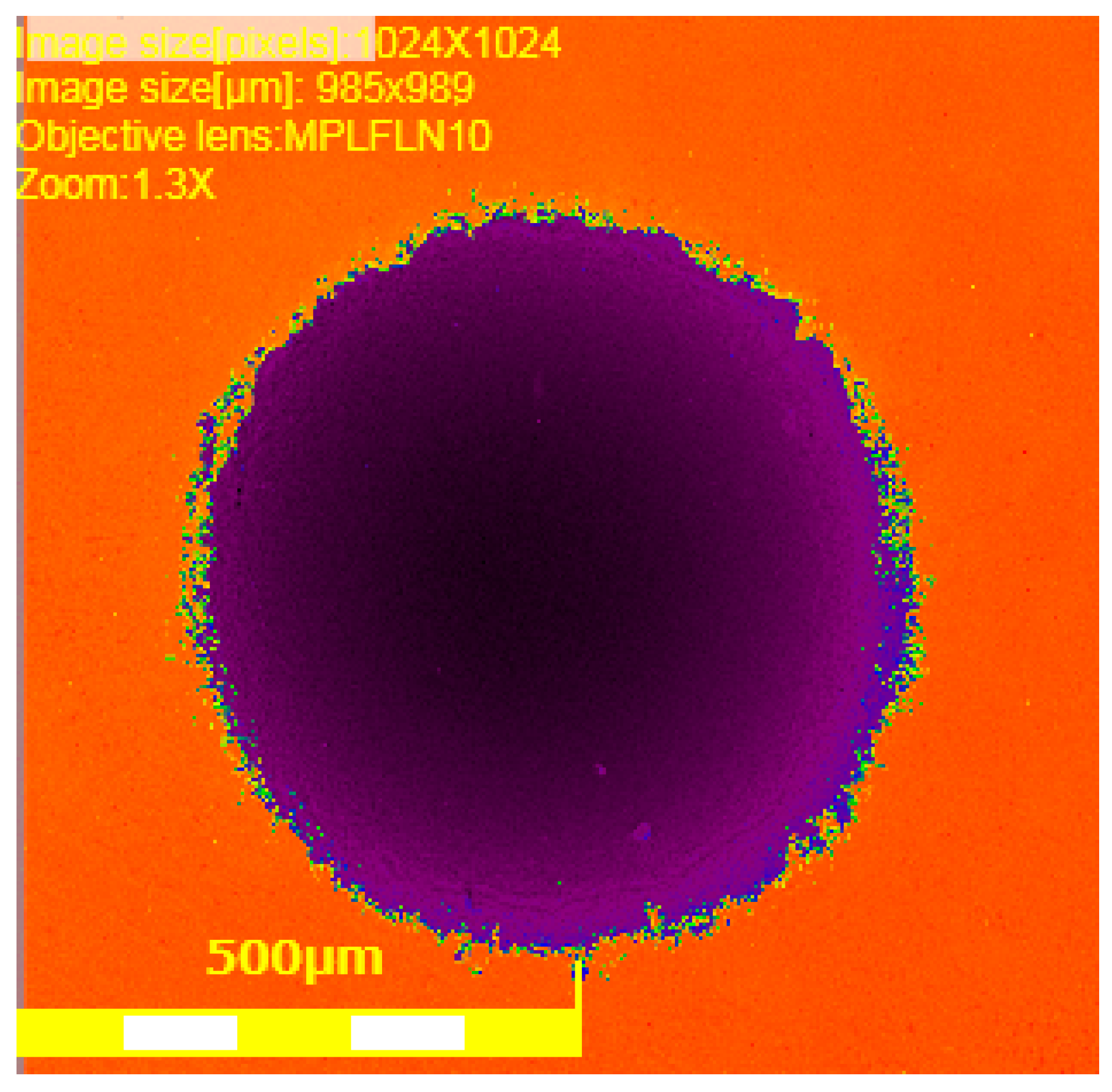
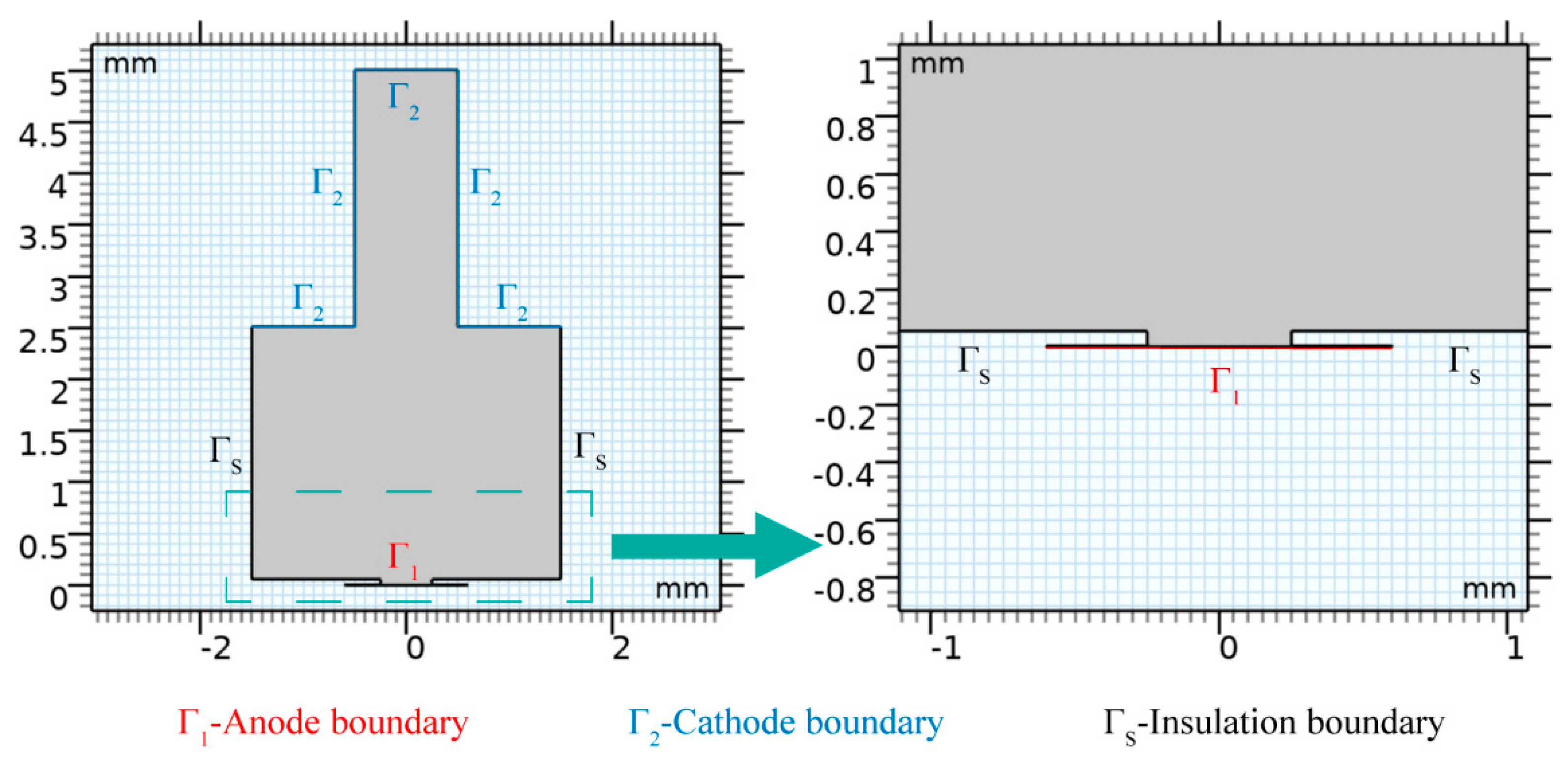


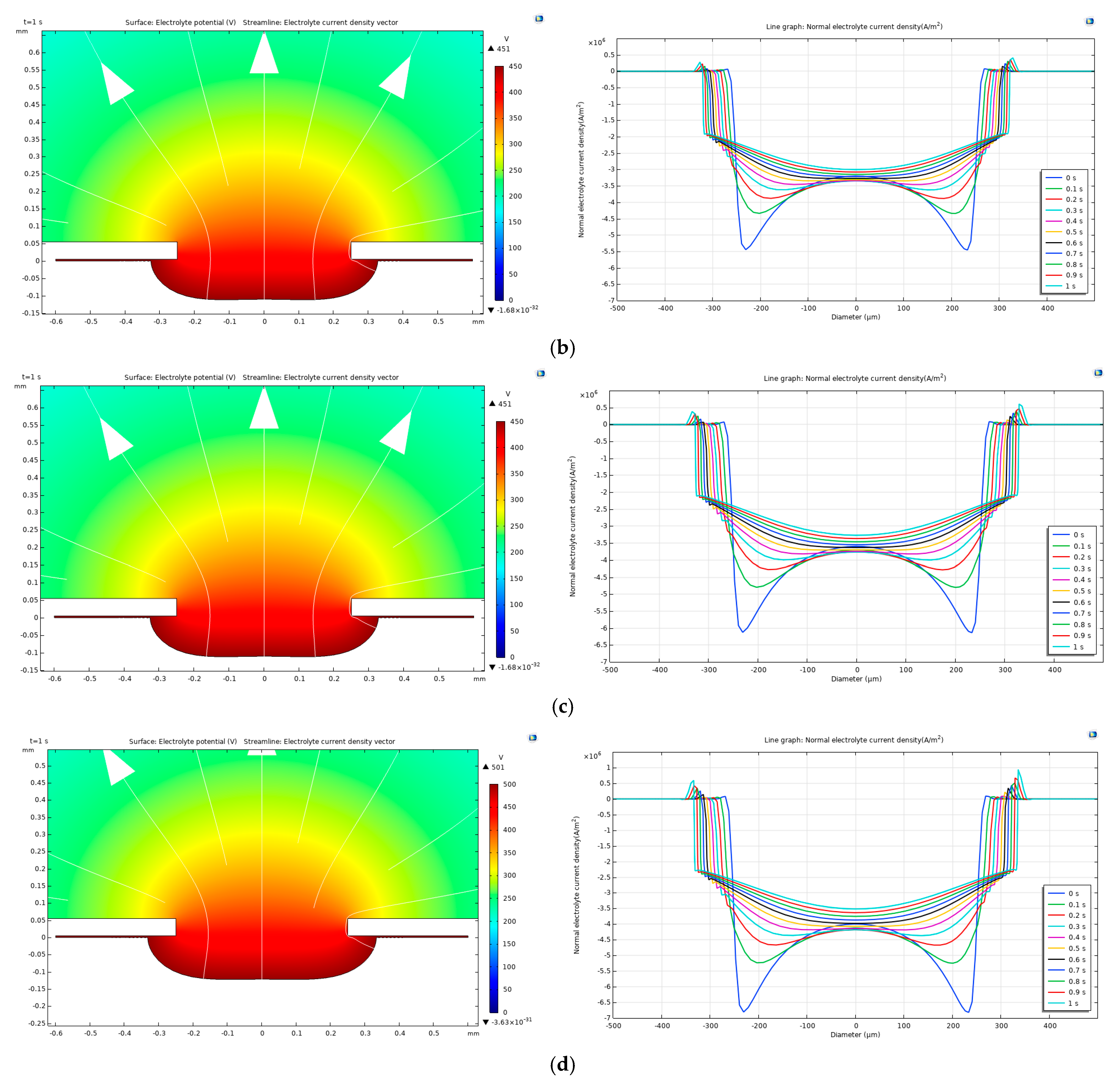
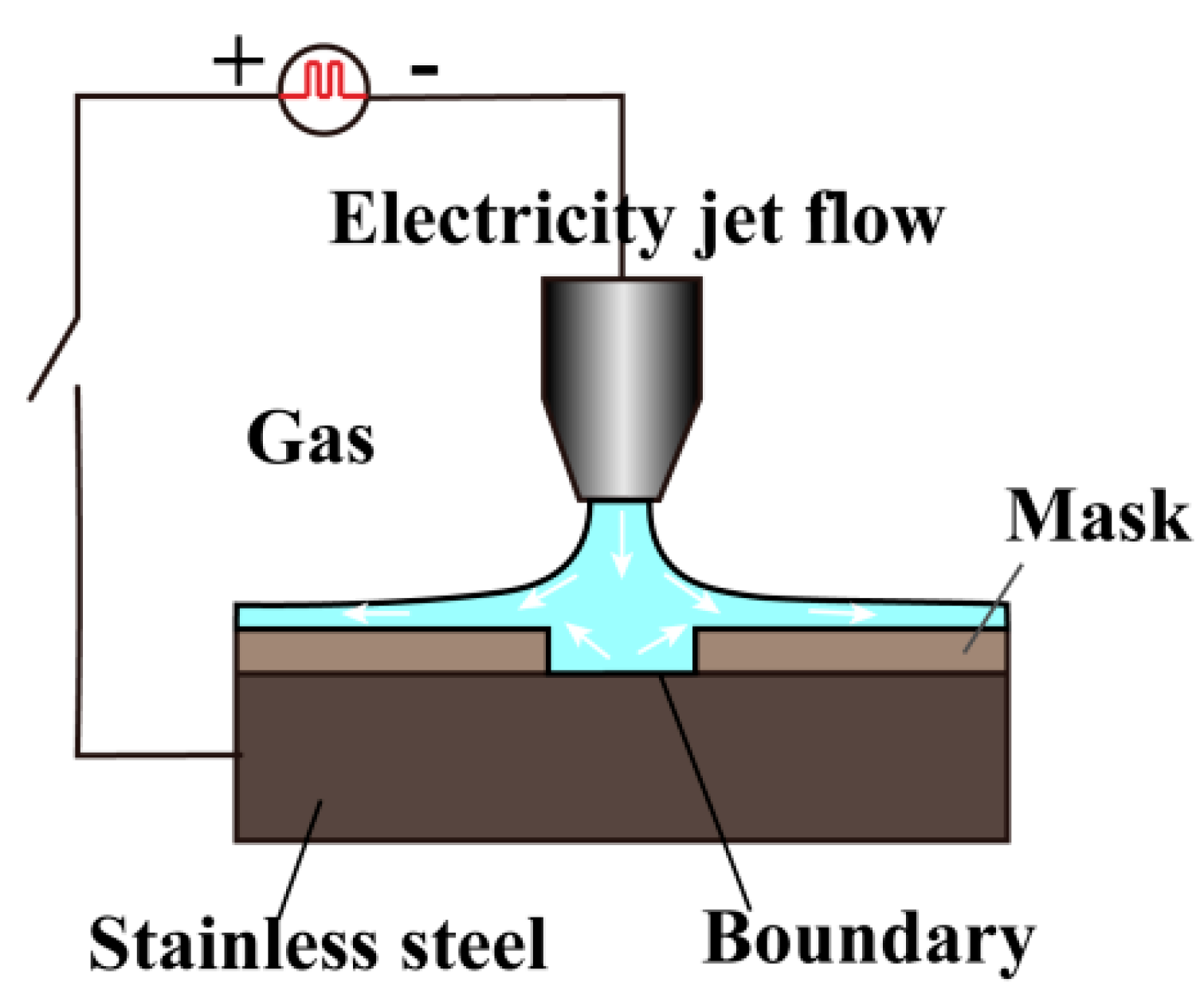
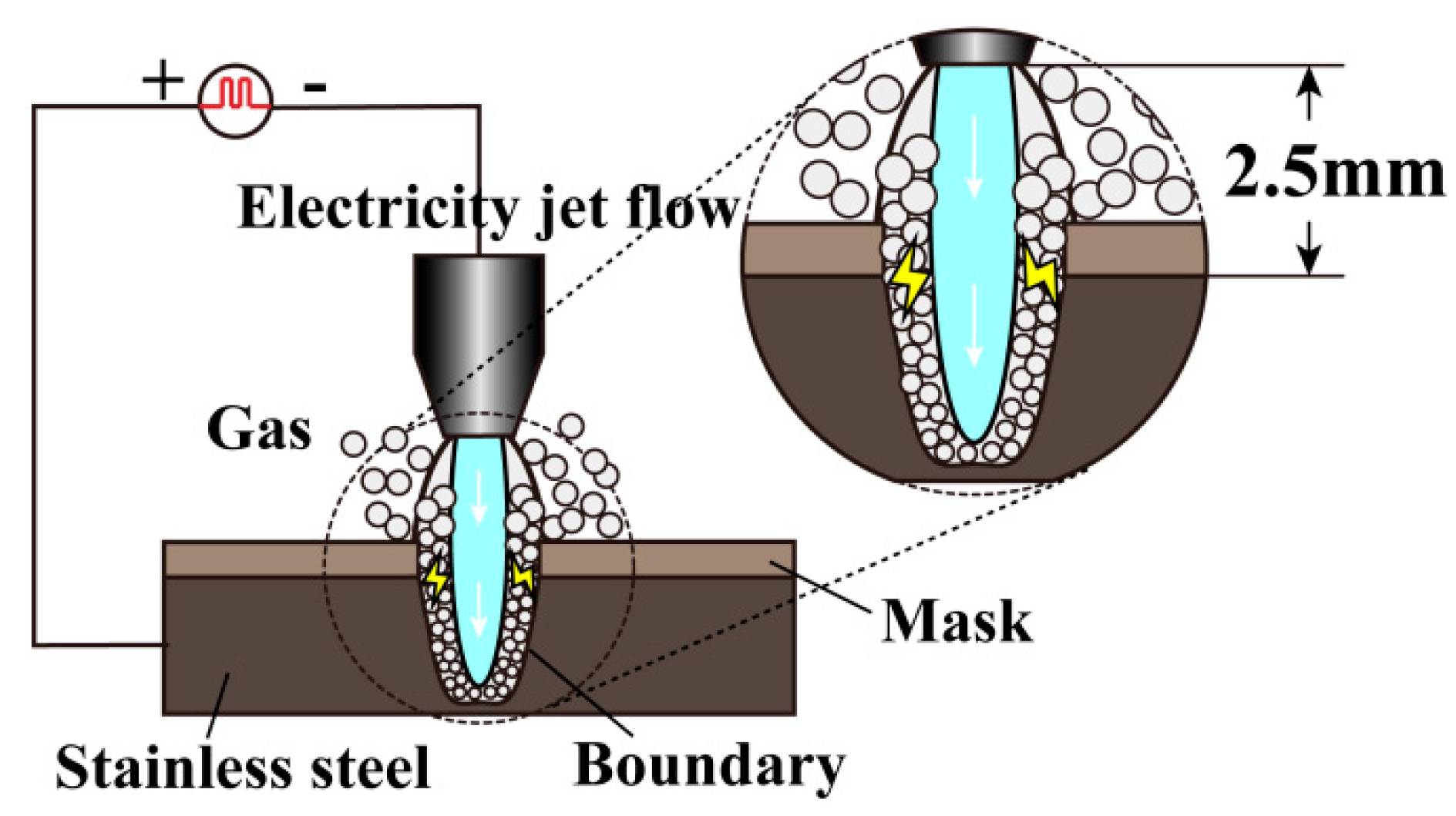
| Machining Voltage | 200 | 225 | 250 | 275 | 300 | 325 | 350 | 375 | 400 | 425 | 450 | 475 | 500 | |
|---|---|---|---|---|---|---|---|---|---|---|---|---|---|---|
| U (V) Machining Gap d (mm) | ||||||||||||||
| 1.5 | × | × | ○ | ○ | √ | √ | √ | ○ | ○ | ○ | ○ | ○ | ○ | |
| 2 | × | × | × | ○ | ○ | ○ | √ | √ | √ | √ | √ | ○ | ○ | |
| 2.5 | × | × | × | × | ○ | ○ | ○ | √ | √ | √ | √ | √ | √ | |
| 3 | × | × | × | × | × | ○ | ○ | ○ | √ | √ | √ | √ | √ | |
| Parameter Name | Numerical Values | Unit |
|---|---|---|
| Voltage | 350, 400, 450, 500 | V |
| Mask diameter | 500 | μm |
| Mask thickness | 50 | μm |
| Machining clearance | 2.50 | mm |
| 304 stainless steel molar quality | 54.94 | g/mol |
| 304 stainless steel density | 7.77 | g/cm3 |
| Electrolyte temperature | 298.15 | K |
| Electrical conductivity | 7.00 | S/m |
| Faraday’s constant | 96,486 | C/mol |
| Electrochemical equivalents | 2.1 × 10−3 | cm3/(A·min) |
Disclaimer/Publisher’s Note: The statements, opinions and data contained in all publications are solely those of the individual author(s) and contributor(s) and not of MDPI and/or the editor(s). MDPI and/or the editor(s) disclaim responsibility for any injury to people or property resulting from any ideas, methods, instructions or products referred to in the content. |
© 2023 by the authors. Licensee MDPI, Basel, Switzerland. This article is an open access article distributed under the terms and conditions of the Creative Commons Attribution (CC BY) license (https://creativecommons.org/licenses/by/4.0/).
Share and Cite
Chen, C.; Wu, S.; Wu, H.; Shan, L.; Li, K.; Wu, S. Discharge Characteristics and Mechanisms of Electrolytic Discharge Processing by Jet Mask. Coatings 2023, 13, 1933. https://doi.org/10.3390/coatings13111933
Chen C, Wu S, Wu H, Shan L, Li K, Wu S. Discharge Characteristics and Mechanisms of Electrolytic Discharge Processing by Jet Mask. Coatings. 2023; 13(11):1933. https://doi.org/10.3390/coatings13111933
Chicago/Turabian StyleChen, Chaoda, Shaofang Wu, Hao Wu, Liang Shan, Kangxing Li, and Siyang Wu. 2023. "Discharge Characteristics and Mechanisms of Electrolytic Discharge Processing by Jet Mask" Coatings 13, no. 11: 1933. https://doi.org/10.3390/coatings13111933
APA StyleChen, C., Wu, S., Wu, H., Shan, L., Li, K., & Wu, S. (2023). Discharge Characteristics and Mechanisms of Electrolytic Discharge Processing by Jet Mask. Coatings, 13(11), 1933. https://doi.org/10.3390/coatings13111933







